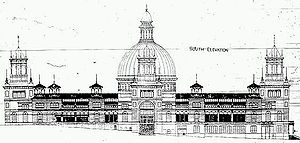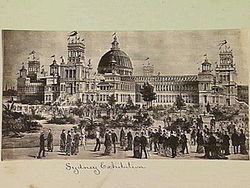
Garden Palace
Encyclopedia


James Barnet
James Johnstone Barnet was the Colonial Architect for New South Wales from 1862 - 1890.-Life and career:Barnet was born at Almericlose, Arbroath, Scotland. The son of a builder, he was educated at the local high school...
and constructed by John Young (http://ramin.com.au/annandale/theabbey.shtml), despite the architect's reservations (http://findarticles.com/p/articles/mi_hb4817/is_1_86/ai_n28776134/pg_9/), at a cost of 191,800 Pounds in only eight months - largely due to the special importation from England of electric lighting which enabled work to be carried out around-the-clock.
A reworking of London's
London
London is the capital city of :England and the :United Kingdom, the largest metropolitan area in the United Kingdom, and the largest urban zone in the European Union by most measures. Located on the River Thames, London has been a major settlement for two millennia, its history going back to its...
Crystal Palace
The Crystal Palace
The Crystal Palace was a cast-iron and glass building originally erected in Hyde Park, London, England, to house the Great Exhibition of 1851. More than 14,000 exhibitors from around the world gathered in the Palace's of exhibition space to display examples of the latest technology developed in...
, it is visually similar in many respects to the later Royal Exhibition Building
Royal Exhibition Building
The Royal Exhibition Building is a World Heritage Site-listed building in Melbourne, Australia, completed in 1880. It is located at 9 Nicholson Street in the Carlton Gardens, flanked by Victoria, Nicholson, Carlton and Rathdowne Streets, at the north-eastern edge of the central business district...
in Melbourne
Melbourne
Melbourne is the capital and most populous city in the state of Victoria, and the second most populous city in Australia. The Melbourne City Centre is the hub of the greater metropolitan area and the Census statistical division—of which "Melbourne" is the common name. As of June 2009, the greater...
; the Sydney
Sydney
Sydney is the most populous city in Australia and the state capital of New South Wales. Sydney is located on Australia's south-east coast of the Tasman Sea. As of June 2010, the greater metropolitan area had an approximate population of 4.6 million people...
building consisted of three turreted wings meeting beneath a central dome. The dome was 100 feet (30.4 metres) in diameter and 210 feet (65.5 metres) in height. Sydney's first hydraulic lift was contained in the north tower. The building was sited at what is today the southwestern end of the Royal Botanic Gardens
Royal Botanic Gardens, Sydney
The Royal Botanic Gardens in Sydney, Australia, are the most central of the three major botanical gardens open to the public in Sydney....
(although at the time it was built it occupied land that was outside the Gardens). It was constructed primarily from timber
Timber
Timber may refer to:* Timber, a term common in the United Kingdom and Australia for wood materials * Timber, Oregon, an unincorporated community in the U.S...
, which was to assure its complete destruction when engulfed by fire
Fire
Fire is the rapid oxidation of a material in the chemical process of combustion, releasing heat, light, and various reaction products. Slower oxidative processes like rusting or digestion are not included by this definition....
in the early morning of September 22, 1882.
The Garden Palace at that time was used by a number of Government Departments and many significant records were destroyed in the fire, notably records of squatting occupation in NSW.
The only extant remains of the Garden Palace are its carved Sydney sandstone
Sydney sandstone
Sydney sandstone is the common name for Sydney Basin Hawkesbury Sandstone, historically known as Yellowblock, is a sedimentary rock named after the Hawkesbury River north of Sydney, where this sandstone is particularly common....
gateposts and wrought iron
Wrought iron
thumb|The [[Eiffel tower]] is constructed from [[puddle iron]], a form of wrought ironWrought iron is an iron alloy with a very low carbon...
gates, located on the Macquarie Street entrance to the Royal Botanical Gardens. A 1940s-era sunken garden and fountain featuring a statue of Cupid
Cupid
In Roman mythology, Cupid is the god of desire, affection and erotic love. He is the son of the goddess Venus and the god Mars. His Greek counterpart is Eros...
marks the former location of the Palace's dome. Few artifacts from the International Exhibition survived the fire, one of which is a carved graphite
Graphite
The mineral graphite is one of the allotropes of carbon. It was named by Abraham Gottlob Werner in 1789 from the Ancient Greek γράφω , "to draw/write", for its use in pencils, where it is commonly called lead . Unlike diamond , graphite is an electrical conductor, a semimetal...
statue of an elephant
Elephant
Elephants are large land mammals in two extant genera of the family Elephantidae: Elephas and Loxodonta, with the third genus Mammuthus extinct...
, from Ceylon, now in the collection of the Powerhouse Museum
Powerhouse Museum
The Powerhouse Museum is the major branch of the Museum of Applied Arts and Sciences in Sydney, the other being the historic Sydney Observatory...
.

